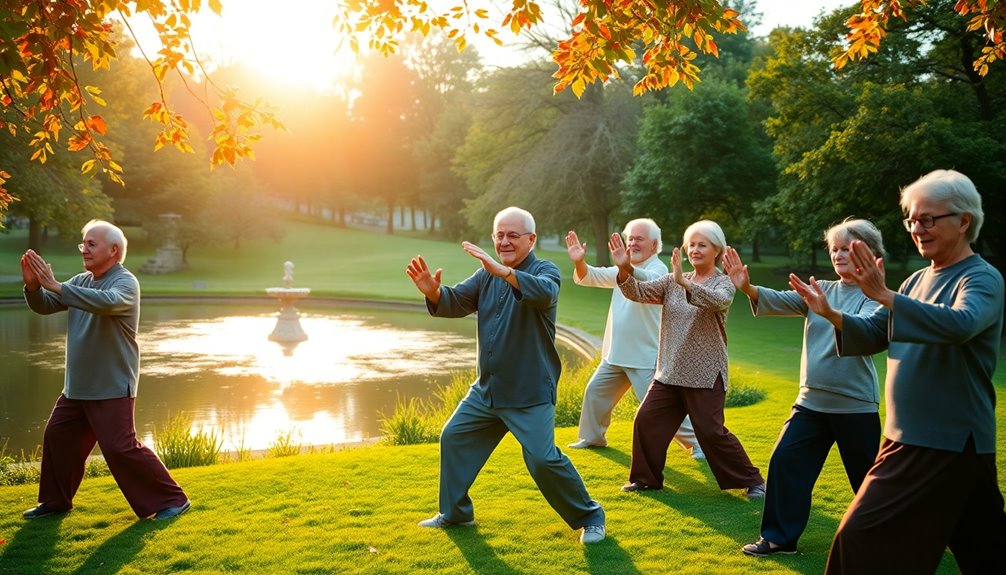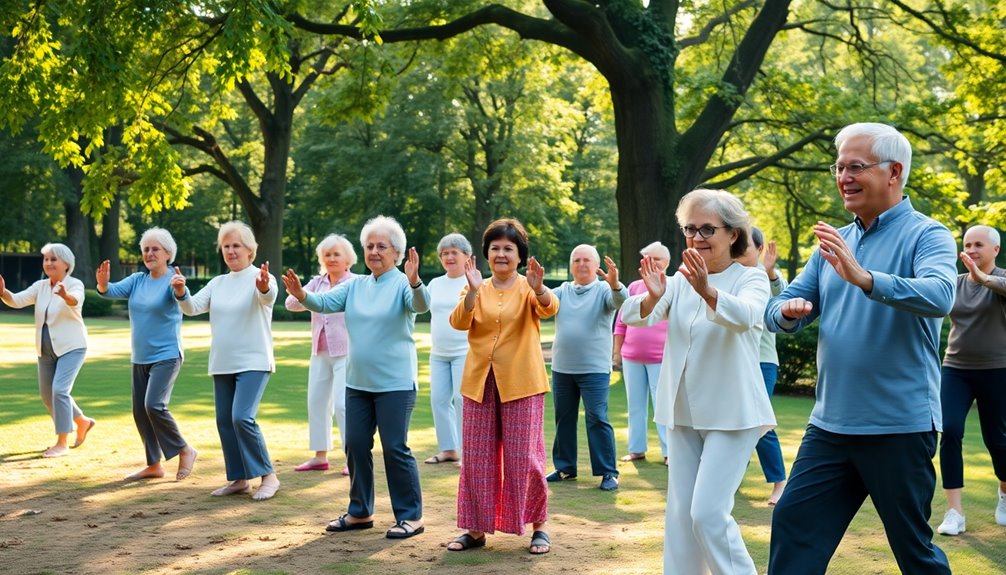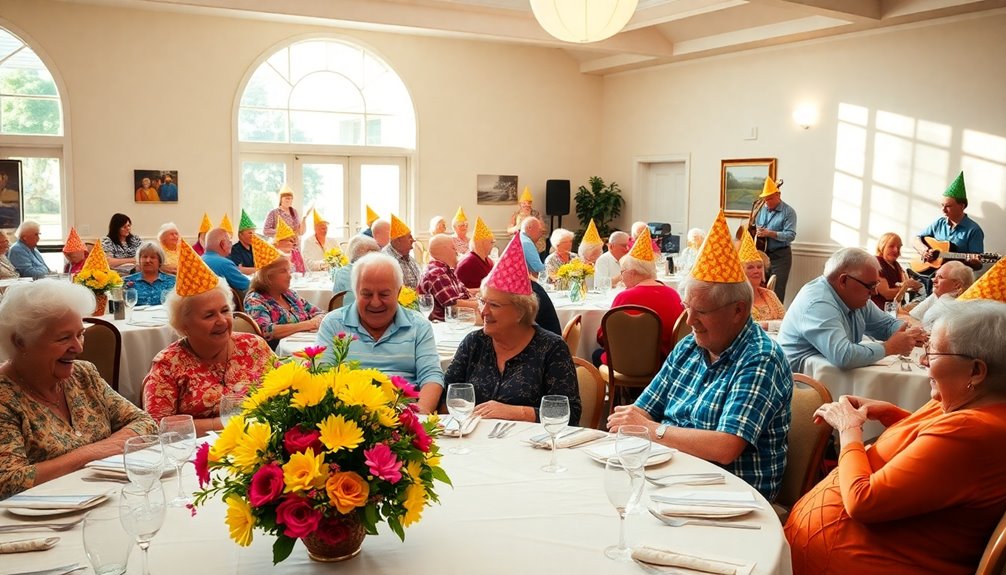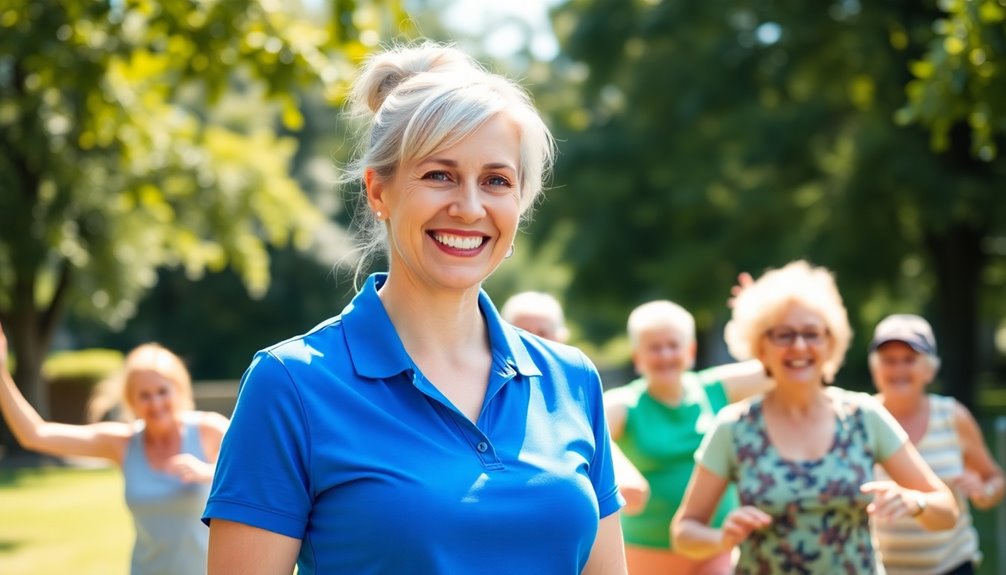Tai Chi is a fantastic option for seniors, combining gentle movements with mindful breathing to boost your health. These slow, flowing exercises improve balance, reducing your risk of falls by up to 50%. You'll experience better mobility and comfort, and its calming practice can also enhance your mental clarity and mood. Regular practice can even lead to reduced pain from conditions like osteoarthritis. Plus, it helps improve overall well-being, with many seniors reporting a significant quality of life boost. Stick around, and you'll uncover more about getting started and the community resources available for you.
Key Takeaways
- Tai Chi enhances balance, reducing fall risk by up to 50% among older adults through gentle, flowing movements.
- Regular practice can improve overall well-being by 30%, alleviating pain and promoting greater mobility.
- Mindful movements in Tai Chi contribute to reduced stress, better sleep quality, and improved mental clarity.
- Essential warmup techniques, like weight shifting and torso twists, prepare the body for safe practice.
- Community resources, including classes and online tutorials, provide accessible support for seniors starting their Tai Chi journey.
Overview of Tai Chi
Tai Chi, often referred to as "moving meditation," offers a gentle way to enhance your physical and mental well-being. This ancient Chinese martial art is characterized by its slow, flowing movements and deep breathing, making it an ideal low-impact exercise for seniors. You can practice Tai Chi regardless of your fitness level, allowing you to engage in gentle movements that promote health benefits.
One of the standout advantages of Tai Chi is its ability to improve balance, a vital factor in fall prevention. Studies show that participating in Tai Chi can reduce fall risk by up to 50% among older adults, enhancing coordination and flexibility.
In addition, regular practice is linked with a 30% improvement in overall well-being, including significant reductions in depression symptoms and better sleep quality.
For seniors, particularly those dealing with chronic conditions like arthritis, Tai Chi's repetitive and accessible movements can strengthen stability and alleviate discomfort.
Moreover, engaging in Tai Chi can contribute to enhanced cognitive function and memory retention. By incorporating Tai Chi into your routine, you can enjoy a holistic approach to physical and mental health that supports your overall quality of life.
Benefits for Seniors

For seniors, the benefits of practicing Tai Chi extend beyond mere movement; they encompass both physical and mental well-being. This gentle exercise offers a variety of health benefits that can considerably enhance your quality of life.
By engaging in Tai Chi, you can:
- Improve balance, reducing the risk of falls by up to 50%
- Alleviate pain from conditions like knee osteoarthritis and back issues
- Reduce stress through its meditative state, contributing to emotional well-being
- Enhance overall physical conditioning, promoting greater mobility and comfort
Regular participation in Tai Chi has been shown to yield a 30% improvement in overall quality of life among seniors.
As you practice, you'll likely experience better sleep quality and a decrease in symptoms of depression. The combination of gentle movements and focused breathing not only helps you stay active but also calms the mind, fostering a happier lifestyle.
With consistent practice, Tai Chi can transform your daily routine into a rejuvenating experience, allowing you to embrace life with confidence and energy.
Mental Health Improvements

Practicing tai chi can markedly reduce stress, helping you feel more relaxed and centered.
You'll also notice improvements in your emotional well-being, leading to a more positive outlook on life.
As you engage in these mindful movements, you'll likely find your mental clarity and overall mood enhancing.
Stress Reduction Techniques
Engaging in tai chi offers seniors a powerful pathway to stress reduction and improved mental health. This gentle practice incorporates mindfulness techniques that help reduce stress and anxiety levels, leading to better emotional well-being.
By participating in Tai Chi for seniors, you can experience notable benefits, including:
- Enhanced mood and reduced symptoms of depression
- Improved quality of life, with studies showing a 30% increase
- Greater mental clarity and relaxation
- Better sleep quality, contributing to overall mental health
The meditative aspects of tai chi not only promote relaxation but also enhance cognitive function, which is essential as we age.
You'll find that your resilience improves, helping you cope with daily challenges. Additionally, engaging in tai chi can meaningfully decrease the fear of falling, a common concern among seniors that often leads to anxiety and reduced physical activity.
As you practice tai chi, you'll likely discover a newfound sense of calm and control over your life, making it a valuable stress reduction technique.
Embracing these gentle movements can lead to a happier, healthier life as you navigate your golden years.
Enhanced Emotional Well-being
Tai chi's gentle movements and mindful focus create a profound impact on emotional well-being, allowing you to experience considerable mental health improvements. By practicing tai chi, you can effectively reduce stress and anxiety, thanks to its mindfulness techniques. This practice is particularly beneficial for older individuals, with studies showing a 30% improvement in overall quality of life.
Regular tai chi sessions can considerably decrease symptoms of depression, helping you cultivate a more positive mood and emotional health. As you engage in these movements, you'll also notice better sleep quality, which is closely linked to resilience and overall mental health.
Improved sleep can lead to enhanced cognitive function and memory retention, further supporting your mental clarity and emotional stability. Incorporating tai chi into your routine not only boosts your emotional well-being but also empowers you to manage stress more effectively.
As you develop resilience through consistent practice, you'll find that your quality of life improves, allowing you to enjoy each day with greater peace and joy. Embrace the benefits of tai chi, and watch as your emotional landscape transforms for the better.
Essential Warmup Exercises

Before you start your Tai Chi practice, it's vital to warm up your body.
These essential warmup exercises not only enhance your balance but also strengthen your leg muscles, helping to prevent falls.
Let's explore some basic techniques that will prepare you for the gentle, flowing movements of Tai Chi.
Importance of Warmup
A proper warmup is essential for seniors practicing tai chi, as it greatly enhances blood circulation and prepares the body for movement. Engaging in warmup exercises not only helps you ease into your tai chi practice but also notably reduces the risk of injury.
Here are some key benefits of warming up:
- Improve balance: Gentle movements like torso twists and weight shifts enhance stability.
- Strengthen leg muscles: Focused warmup exercises target the leg muscles, vital for tai chi.
- Increase flexibility: A proper warmup routine allows for a greater range of motion, making tai chi movements more effective.
- Promote relaxation: Incorporating deep breathing during warmups sets a calm tone, enhancing mental clarity.
These gentle movements gradually increase your body temperature, preparing your muscles and joints for more dynamic actions.
By prioritizing your warmup, you'll not only boost blood circulation but also improve your overall performance during tai chi practice.
Basic Warmup Techniques
Engaging in basic warmup techniques is essential for getting the most out of your tai chi practice. These warmup exercises not only prepare your body but also improve balance and strengthen your leg muscles. By incorporating controlled movements like weight shifting and torso twists, you enhance stability and mobility, vital for seniors' safety during practice.
To set the right tone, start with deep breathing, which promotes mental focus and relaxation. One effective warmup movement is Energy to the Sky, which boosts core stability and back strength. Aim to repeat this movement at least five times to maximize its benefits.
Here's a simple table of basic warmup techniques:
| Warmup Exercise | Benefits | Suggested Repetitions |
|---|---|---|
| Weight Shifting | Improves balance | 5-10 |
| Torso Twists | Enhances mobility | 5-10 |
| Energy to the Sky | Promotes core stability | 5 |
| Deep Breathing | Increases relaxation and focus | 5-10 deep breaths |
| Gentle Arm Circles | Loosens shoulder tension | 5-10 |
Incorporating these warmup exercises into your Tai Chi routine can greatly reduce the risk of injury and improve your overall performance.
Key Tai Chi Movements

Tai Chi offers a beautiful blend of movement and mindfulness, making it an ideal exercise for seniors. By practicing specific Tai Chi movements, you can enjoy numerous health benefits, including improved balance, flexibility, and core strength.
Here are some key movements to incorporate into your routine:
- Energy to the Sky: Push your arms overhead to enhance core stability and back strength. Repeat at least 5 times for improved flexibility and balance.
- Drawing the Bow: Squat and twist to open your chest and lungs. Aim for 3 repetitions on each side for effective stretching and coordination.
- Penetrating Heaven and Earth: This movement stretches your shoulders and promotes energy flow. Repeat at least 8 times to enhance mobility.
- Parting the Wild Horses Mane: Circular movements stretch and open your body, contributing to flexibility and coordination.
Additionally, Brush Knee and Twist Step focuses on stretching and twisting to enhance energy flow, which is essential for fall prevention among older adults.
Engaging in these gentle movements can greatly improve your overall health and well-being as you age.
Getting Started Safely

Practicing Tai Chi can be a rewarding experience, but getting started safely is important for maximizing its benefits. Before you begin, consult with your healthcare provider to confirm Tai Chi is suitable for your individual health conditions and physical abilities.
Starting under the guidance of a qualified instructor is highly recommended. They can teach you proper techniques, which is especially essential if you have limited mobility or chronic conditions.
Make certain you practice in a clear and safe environment to minimize fall risks. This is critical, as Tai Chi can help reduce the risk of falls by up to 50% in older adults.
Wearing supportive footwear and loose-fitting clothing will enhance your comfort and mobility, allowing for smoother movements and better balance.
Begin with gentle warm-up exercises to prepare your body for movement. Incorporating breath control during your practice can also enhance your overall performance and reduce the risk of injury.
With these precautions in place, you'll set yourself up for a fulfilling Tai Chi journey that promotes better health and well-being.
Community Resources and Classes

Finding the right community resources and classes can enrich your Tai Chi experience and make it more enjoyable. Many local community centers and senior facilities offer Tai Chi classes specifically designed for seniors, usually held 2-3 times a week. These classes accommodate varying fitness levels, providing a supportive environment for practicing gentle movements.
Consider these options:
- In-person Tai Chi classes at community centers for hands-on instruction and social interaction.
- Online Tai Chi classes that allow you to practice from home, making it easier to stay consistent.
- Resources like DVDs and online tutorials for those who prefer at-home practice, though professional guidance is always recommended for safety and technique.
- Programs tailored for seniors with limited mobility, ensuring everyone can experience Tai Chi's benefits.
Not only do these community resources promote physical exercise, but they also foster emotional well-being by helping you forge connections with others.
Engaging in Tai Chi can combat loneliness and enhance your overall quality of life. Whether you choose in-person or online options, the key is to find what works best for you.
Frequently Asked Questions
What Is the Best Form of Tai Chi for Seniors?
When considering the best form of Tai Chi for seniors, you'll find Yang and Wu styles particularly beneficial. They focus on gentle, slow movements that enhance balance and flexibility, making them ideal for your practice.
What Is the Most Beneficial Exercise for Seniors?
While high-impact workouts may energize some, gentle exercises are often more beneficial for seniors. You'll find that activities like walking or swimming enhance your strength, flexibility, and overall well-being, promoting a healthier, more active lifestyle.
How Often Should Seniors Do Tai Chi?
You should practice Tai Chi 2-3 times a week for the best results. Each session can last around 60 minutes, helping improve balance, reduce fall risk, and enhance your overall quality of life.
What Is a Disadvantage With Tai Chi?
One disadvantage with Tai Chi is the time it takes to master its slow movements. You might feel frustrated if you prefer a quicker-paced workout and could experience initial muscle soreness as your body adjusts.
Conclusion
Incorporating Tai Chi into your routine can be like planting seeds for a healthier life. With its gentle movements and focus on mindfulness, you'll not only improve your physical health but also nurture your mental well-being. Remember, it's never too late to start this rewarding practice. So, step into a class or find a community group, and watch your strength and balance blossom. Embrace the journey, and let Tai Chi guide you toward a vibrant, healthier future.









